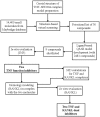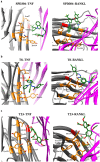Cheminformatics-aided discovery of small-molecule Protein-Protein Interaction (PPI) dual inhibitors of Tumor Necrosis Factor (TNF) and Receptor Activator of NF-κB Ligand (RANKL)
- PMID: 28426652
- PMCID: PMC5398486
- DOI: 10.1371/journal.pcbi.1005372
Cheminformatics-aided discovery of small-molecule Protein-Protein Interaction (PPI) dual inhibitors of Tumor Necrosis Factor (TNF) and Receptor Activator of NF-κB Ligand (RANKL)
Abstract
We present an in silico drug discovery pipeline developed and applied for the identification and virtual screening of small-molecule Protein-Protein Interaction (PPI) compounds that act as dual inhibitors of TNF and RANKL through the trimerization interface. The cheminformatics part of the pipeline was developed by combining structure-based with ligand-based modeling using the largest available set of known TNF inhibitors in the literature (2481 small molecules). To facilitate virtual screening, the consensus predictive model was made freely available at: http://enalos.insilicotox.com/TNFPubChem/. We thus generated a priority list of nine small molecules as candidates for direct TNF function inhibition. In vitro evaluation of these compounds led to the selection of two small molecules that act as potent direct inhibitors of TNF function, with IC50 values comparable to those of a previously-described direct inhibitor (SPD304), but with significantly reduced toxicity. These molecules were also identified as RANKL inhibitors and validated in vitro with respect to this second functionality. Direct binding of the two compounds was confirmed both for TNF and RANKL, as well as their ability to inhibit the biologically-active trimer forms. Molecular dynamics calculations were also carried out for the two small molecules in each protein to offer additional insight into the interactions that govern TNF and RANKL complex formation. To our knowledge, these compounds, namely T8 and T23, constitute the second and third published examples of dual small-molecule direct function inhibitors of TNF and RANKL, and could serve as lead compounds for the development of novel treatments for inflammatory and autoimmune diseases.
Conflict of interest statement
Georgia Melagraki, Georgios Leonis and Antreas Afantitis are employed by Novamechanics Ltd, a drug design company. Other authors declare that there are no conflicts of interest.
Figures







Similar articles
-
In Silico Discovery of Plant-Origin Natural Product Inhibitors of Tumor Necrosis Factor (TNF) and Receptor Activator of NF-κB Ligand (RANKL).Front Pharmacol. 2018 Jul 25;9:800. doi: 10.3389/fphar.2018.00800. eCollection 2018. Front Pharmacol. 2018. PMID: 30090063 Free PMC article.
-
Discovery of Small-Molecule Inhibitors of Receptor Activator of Nuclear Factor-κB Ligand with a Superior Therapeutic Index.J Med Chem. 2020 Oct 22;63(20):12043-12059. doi: 10.1021/acs.jmedchem.0c01316. Epub 2020 Oct 2. J Med Chem. 2020. PMID: 32955874
-
A RANKL G278R mutation causing osteopetrosis identifies a functional amino acid essential for trimer assembly in RANKL and TNF.Hum Mol Genet. 2012 Feb 15;21(4):784-98. doi: 10.1093/hmg/ddr510. Epub 2011 Nov 7. Hum Mol Genet. 2012. PMID: 22068587
-
Current Status and Future Prospects of Small-molecule Protein-protein Interaction (PPI) Inhibitors of Tumor Necrosis Factor (TNF) and Receptor Activator of NF-κB Ligand (RANKL).Curr Top Med Chem. 2018;18(8):661-673. doi: 10.2174/1568026618666180607084430. Curr Top Med Chem. 2018. PMID: 29875003 Review.
-
A new member of tumor necrosis factor ligand family, ODF/OPGL/TRANCE/RANKL, regulates osteoclast differentiation and function.Biochem Biophys Res Commun. 1999 Mar 24;256(3):449-55. doi: 10.1006/bbrc.1999.0252. Biochem Biophys Res Commun. 1999. PMID: 10080918 Review.
Cited by
-
In Silico Prediction of Drug-Induced Liver Injury Based on Ensemble Classifier Method.Int J Mol Sci. 2019 Aug 22;20(17):4106. doi: 10.3390/ijms20174106. Int J Mol Sci. 2019. PMID: 31443562 Free PMC article.
-
Virtual Prediction of the Delphinidin-3-O-glucoside and Peonidin-3-O-glucoside as Anti-inflammatory of TNF-α Signaling.Acta Inform Med. 2019 Sep;27(3):152-157. doi: 10.5455/aim.2019.27.152-157. Acta Inform Med. 2019. PMID: 31762569 Free PMC article.
-
Mimicking Intermolecular Interactions of Tight Protein-Protein Complexes for Small-Molecule Antagonists.ChemMedChem. 2017 Nov 8;12(21):1794-1809. doi: 10.1002/cmdc.201700572. Epub 2017 Oct 23. ChemMedChem. 2017. PMID: 28960868 Free PMC article.
-
Identification of novel inhibitors of Keap1/Nrf2 by a promising method combining protein-protein interaction-oriented library and machine learning.Sci Rep. 2021 Apr 1;11(1):7420. doi: 10.1038/s41598-021-86616-1. Sci Rep. 2021. PMID: 33795749 Free PMC article.
-
In Silico Identification and Evaluation of Natural Products as Potential Tumor Necrosis Factor Function Inhibitors Using Advanced Enalos Asclepios KNIME Nodes.Int J Mol Sci. 2021 Sep 23;22(19):10220. doi: 10.3390/ijms221910220. Int J Mol Sci. 2021. PMID: 34638561 Free PMC article.
References
-
- Beutler B, Milsark IW, Cerami AC. Passive immunization against cachectin/tumor necrosis factor protects mice from lethal effect of endotoxin. Science. 1985;229: 869–871. - PubMed
-
- Kollias G, Douni E, Kassiotis G, Kontoyiannis D. On the role of tumor necrosis factor and receptors in models of multiorgan failure, rheumatoid arthritis, multiple sclerosis and inflammatory bowel disease. Immunol Rev. 1999;169: 175–194. - PubMed
-
- Black RA, Rauch CT, Kozlosky CJ, Peschon JJ, Slack JL, Wolfson MF, et al. A metalloproteinase disintegrin that releases tumour-necrosis factor-alpha from cells. Nature. 1997. pp. 729–733. - PubMed
Publication types
MeSH terms
Substances
LinkOut - more resources
Full Text Sources
Other Literature Sources

